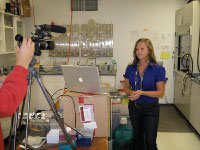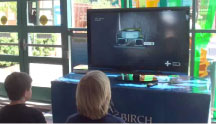COSEE California, a regional center first funded in 2002, is a partnership between University of California Berkeley Lawrence Hall of Science (LHS), Scripps Institution of Oceanography, San Diego Unified School District, College of Exploration, and University of Hawaii. The following are three highlights from our recent work.
Ocean Sciences Curriculum Sequences
| Ocean Sciences Curriculum Sequence |
Working on the Ocean Sciences Curriculum Sequence has enriched me both as an educator and as a scientist - it is a rare opportunity to sit with top-notch scientists and brilliant educators to think deeply about what is important in ocean science, and what we feel a young student really needs to know to interpret and appreciate the world around them. It not only helps the students, but it helps us to see the world and our science through fresh eyes. –Dr. Drew Talley, University of San Diego and Ocean Discovery Institute |
|
|
|
The Ocean Sciences Curriculum Sequences (OSS) for Grades 3-5 and 6-8 is a COSEE California initiative funded by NOAA Environmental Literacy Grants in 2007 and 2009. Both involve a partnership between COSEE California and COSEE NOW at Rutgers University. In order to reach the widest possible audience, OSS is designed to be adopted and incorporated into the mainstream science program by entire states or school systems. OSS Grades 3-5 has just been published (February 2011), and OSS Grades 6-8 will follow in 2012. The development process serves as a model for how scientists and science educators can effectively work together in a collaborative and iterative process that results in a high impact product.
The development process for OSS emphasized strategic, ongoing collaboration between scientists and educators. OSS brought scien¬tists and educators together to develop a balanced approach for inserting ocean sciences content into the mainstream K-12 science curriculum. Ocean Literacy: The Essential Principles of Ocean Sciences K-12 and the Ocean Literacy Scope and Sequence for Grades K-12 provided the conceptual foundation for the curriculum.
Scientists and educators began the development process by drawing on current research in ocean sciences and science learning, to form the conceptual framework, the progression of concepts, and the unit topics. Scientists then served as advisors and reviewers of the instructional materials, and scientist feedback was iteratively incorporated into the pilot (taught by COSEE California developers in three classrooms), the national trial (taught by 70 teachers nationwide), and the final versions of the curriculum. These interactions around the curriculum development have led to lasting partnerships and collaborations on several subsequent projects. COSEE SouthEast and COSEE OCEAN are now planning to implement OSS Grades 3-5 in several large urban school districts.
The OSS materials have the potential to become the most widely used K-8 ocean sciences curriculum nationwide. We anticipate that thousands of teachers will, for the first time, use ocean sciences to address their science standards, reaching unprecedented numbers of students. OSS materials provide teachers with essential tools for advancing Earth systems science and ocean literacy. They also provide a proof-of-concept - that content about the ocean can be incorporated into elementary and middle schools in order to enhance learning, address standards, and build on existing instructional programs.
| |  |
| Students and the lab staff were able to see and interact with each other in a videoconference as well as view slides as needed. Almost 300 students participated over the course of 9 videoconferences in three days. |
Teaching Ocean Sciences in the 21st Century Classroom: Lab to Classroom Videoconferencing
The Teaching Ocean Science in the 21st Century Classroom initiative is a collection of COSEE California activities aimed at developing and disseminating technology-based instructional strategies and tools, and ocean science resources, for both formal and informal science education. San Diego Unified School District (SDUSD) and the Birch Aquarium at Scripps (BAS) are partners in this initiative. As with all COSEE California activities, the ultimate goal is a sustainable model in which researchers continue to engage in the activities as part of the broader impact components of their research.
Advances in information and communications technology (ICT) is making it easier to connect students and researchers using simple videoconferencing tools (e.g. Skype and Acrobat Connect) that allow students and researchers to interact in novel ways. COSEE California is experimenting with these tools and approaches: to identify effective practice in using ICT, to provide students with insight into the research process, and to make close connections to researchers and their laboratory activities. At the same time, researchers, particularly graduate students, are learning effective communication skills, and how to align their presentations to specific classroom needs – all from the comfort of their own lab. Importantly, this next generation of ocean scientists is being empowered to carry what they learn into their future outreach activities.
 | |
Graduate student Emily Trentacoste explains her lab’s research on the uses of tropical marine algae in drug discovery in a live two-way broadcast between Bill Gerwick's Lab and classrooms at Pershing Middle School | |
In 2010, three Scripps graduate students and the lab PI, Bill Gerwick, connected to nine 7th grade life science classes via Skype, in a series of nine 45-minute videoconferences on the topic of marine natural products research. This project is an ongoing partnership between the Gerwick Lab and a group of three 7th grade life science teachers at Pershing Middle School. The Pershing science teachers collaborate on an intensive, semester-long unit focused on drug discovery. Capitalizing on the teacher team’s well-developed unit of study and the obvious overlap with leading-edge research at Scripps, COSEE California has been experimenting with optimal approaches to structuring this activity, in order to most effectively reach the students. The lab PI and graduate students conducted a mini-lab tour, presented a simple Powerpoint presentation of their research activities, and fielded student questions throughout the presentation.
Teachers are currently writing up the “how to” document that will be distributed to other teachers in the district, and are exploring ways they can further capitalize on the connection to the research lab. In the interest of sustainability, the collaboration is being turned over to the graduate students and teachers with little facilitation by COSEE California staff. We are also working to apply this approach to other ocean science topics by offering “Virtual Lab Tours” as a broader impact option for researchers.
Xbox: Serious Gaming for Science
| |  |
| Boys (9 and 13 years old) testing out the Xbox 360 Deep-Sea Extreme Environment Pilot game at the Birch Aquarium at Scripps |
COSEE California recognizes the need to support education and outreach associated with large NSF science initiatives such as the Ocean Observatories Initiative. Working toward providing innovative ways to interest and engage the public in observatories and observatory science, COSEE California is collaborating with the OOI Cyberinfrastructure Education team to create a prototype game for use in an informal science setting.
Serious gaming is a burgeoning field of education, but to date the focus has been on 2D games that are designed for long-term play. Little work has been done on determining the efficacy of using popular gaming platforms like the Xbox in unconventional settings such as science centers. Our game is built on an Xbox platform using open source software. Some advantages of using this popular gaming technology include the ability to support the games on any Xbox 360 console or Windows-based desktop machine, as well as the use of standard Xbox gaming controls already familiar to a large number of middle and high school students, as well as many adults. These games can potentially serve as integral components of problem-based learning activities, and be structured to promote higher-order thinking skills in an entertaining context.
Two prototype games are currently in various stages of development: one focused on exploration of hydrothermal vents, and one focused on manipulating equipment that is part of a seafloor cabled observatory. The games have been piloted with audiences at the Birch Aquarium at Scripps and modifications were made based on user feedback. A formal, formative evaluation of the most recent and most sophisticated version of the game was conducted in August 2010, and focused on students enrolled in the Birch Aquarium summer camps. A trailer for the most recent versions of the games is available on YouTube.
Visit COSEE California!

